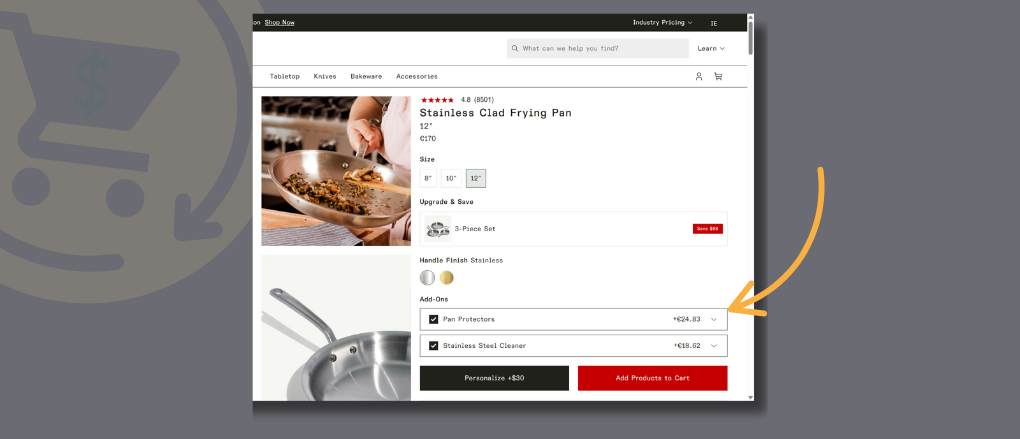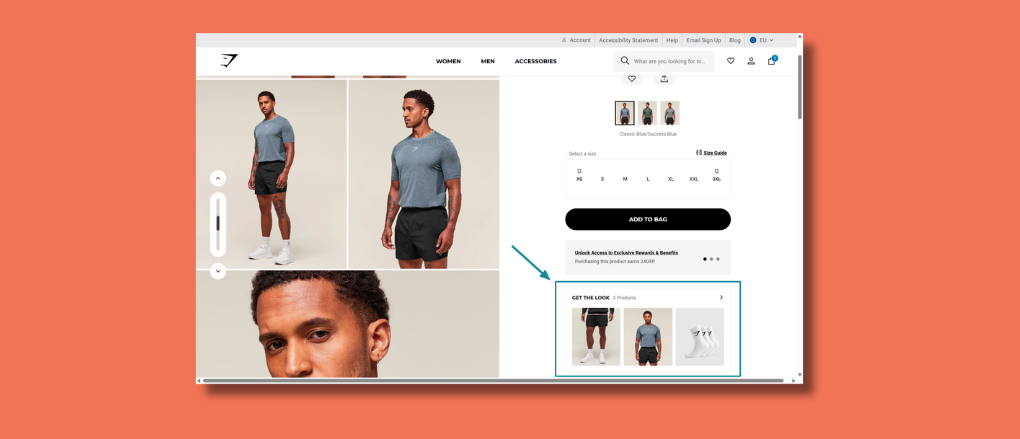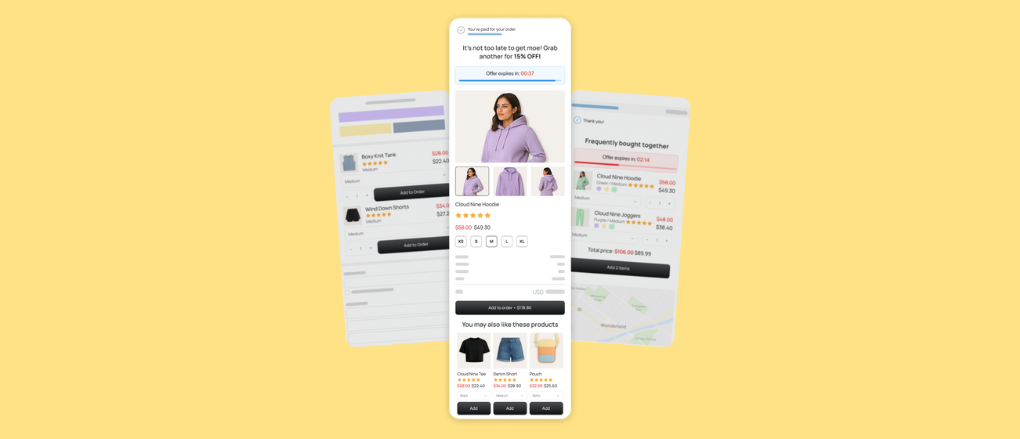What is Upselling? A Simple Guide for Sellers
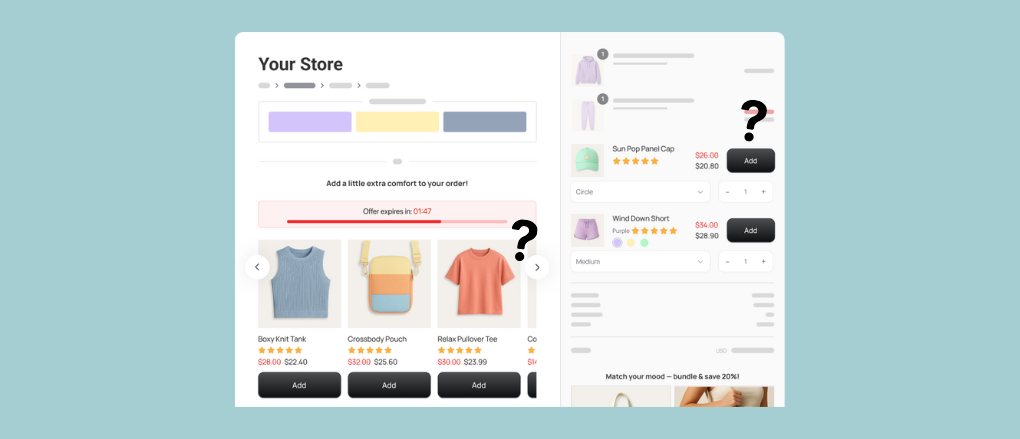
Upselling is an essential tactic for e-commerce. Done well, it can drive 10–30% more revenue, lift average order value, and even boost customer loyalty.
So, what is upselling in retail exactly - and how can you use it to its full potential?
In this guide, we’ll break down the basics, show you real examples, and give you practical strategies you can apply today.
Let’s jump in!
What is Upselling?
Upselling is a sales tactic that encourages customers to purchase a higher-end product or an upgrade that enhances the overall value of their order.
The goal is simple: maximize revenue while delivering more value to the customer.
Now, upselling is sometimes colloquially used as an umbrella term for several related tactics. And it’s easy to get confused. So, let’s straighten them out with the help of AOV-boosting professionals, McDonald’s:
- Upselling: Offering a better, more expensive variation of the same product. Example: Going supersize on

- Cross-selling: Suggesting add-ons that complement your customer’s main product: Example,’ Would you like fries with that?’
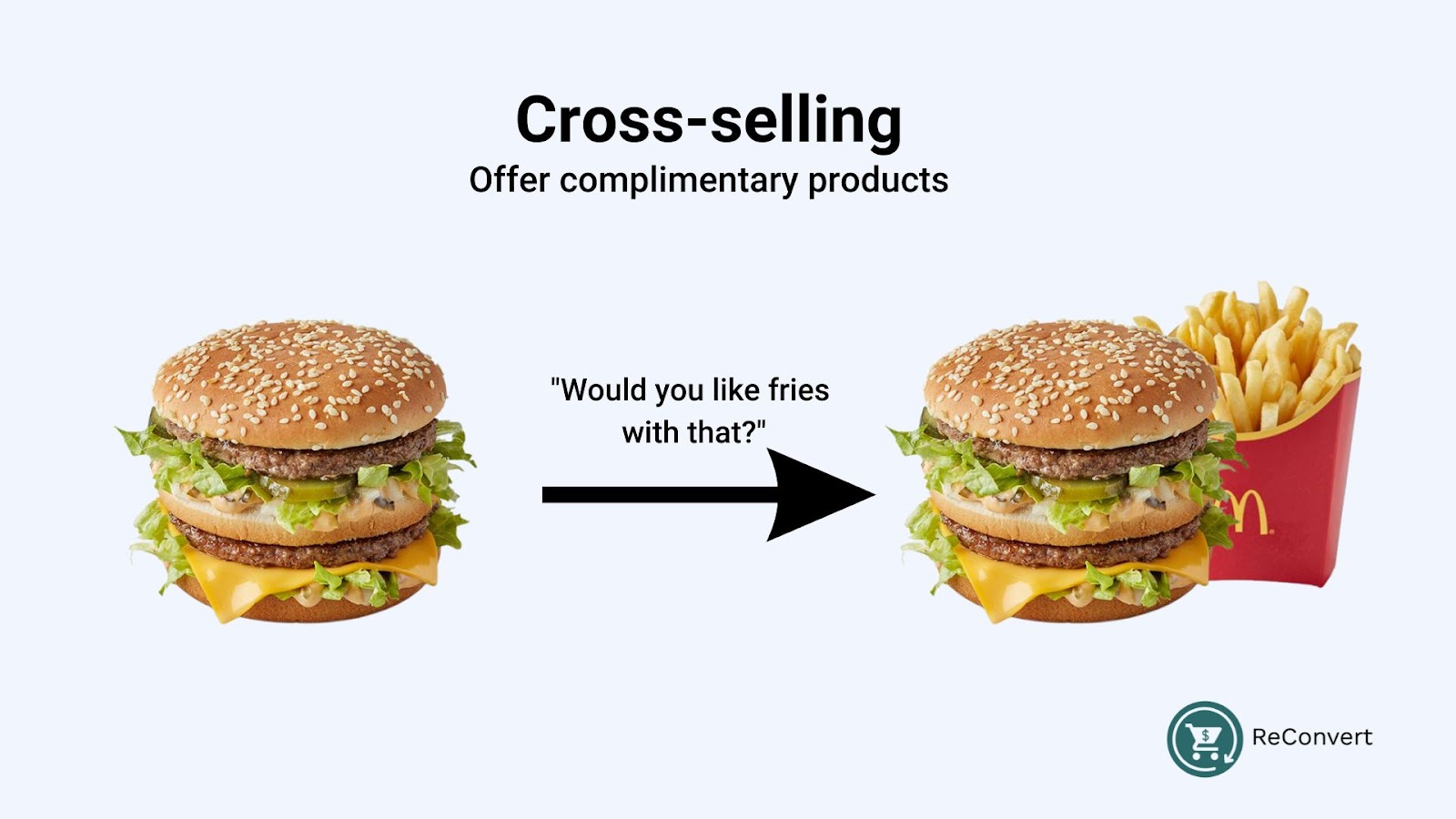
- Product Bundling: Combining multiple products into one package (often at a discount). Example: “Make it a meal for $2 extra.”
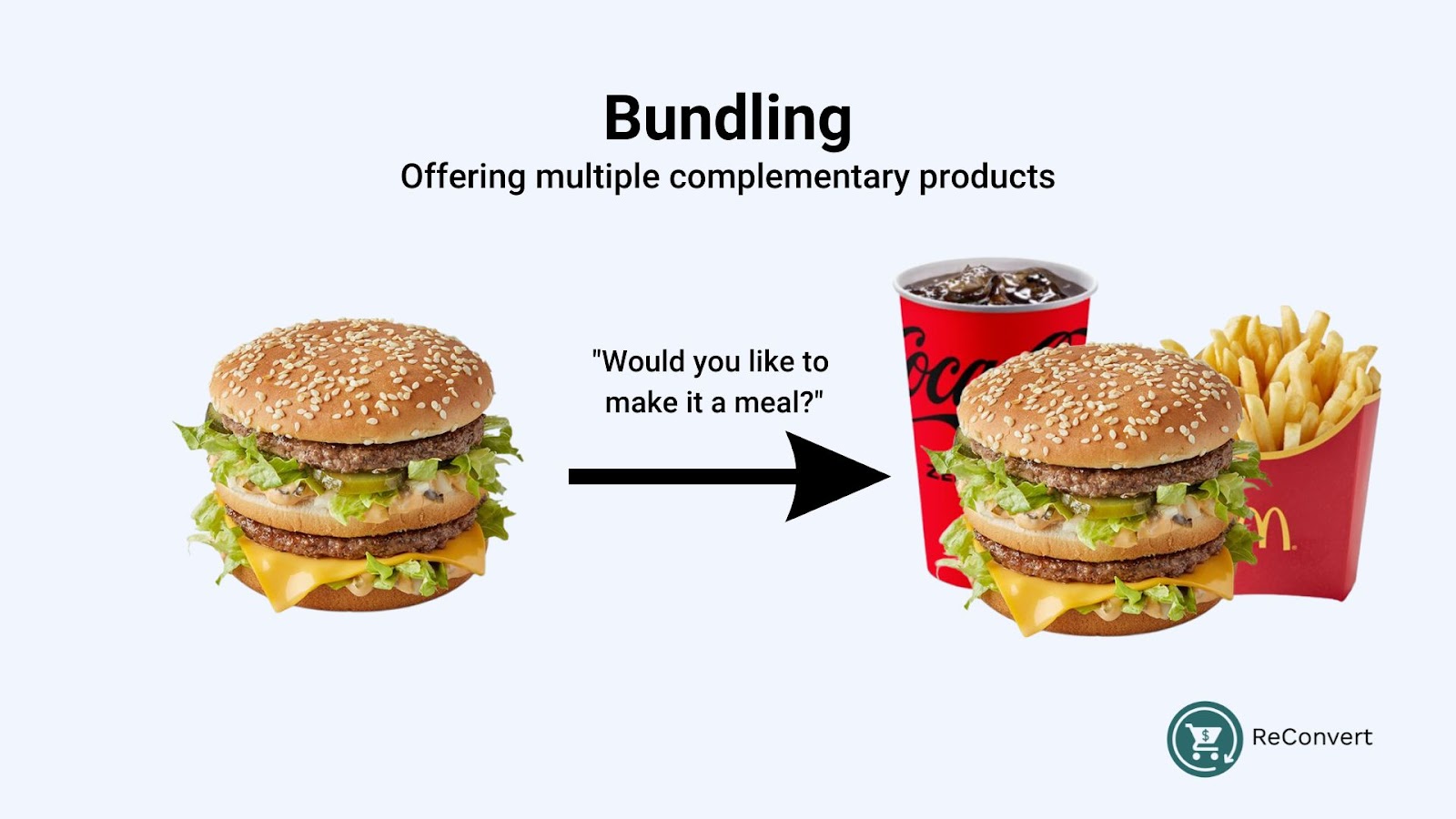
- Down-selling: Offering a cheaper alternative to the main product. Often used when price is the main obstacle to purchase. Example: McDonald’s Dollar menu.
.jpg)
Upselling vs. Cross-Selling: Which is More Effective?
Upselling and cross-selling both drive revenue, but they work in different ways.
- Upselling boosts average order value (AOV) by moving customers to a higher-priced version of what they already want.
- Cross-selling adds complementary products that increase cart size without replacing the original item.
Which one works better? It depends on the context.
Upselling usually has a bigger impact on AOV since it’s tied to the core purchase.
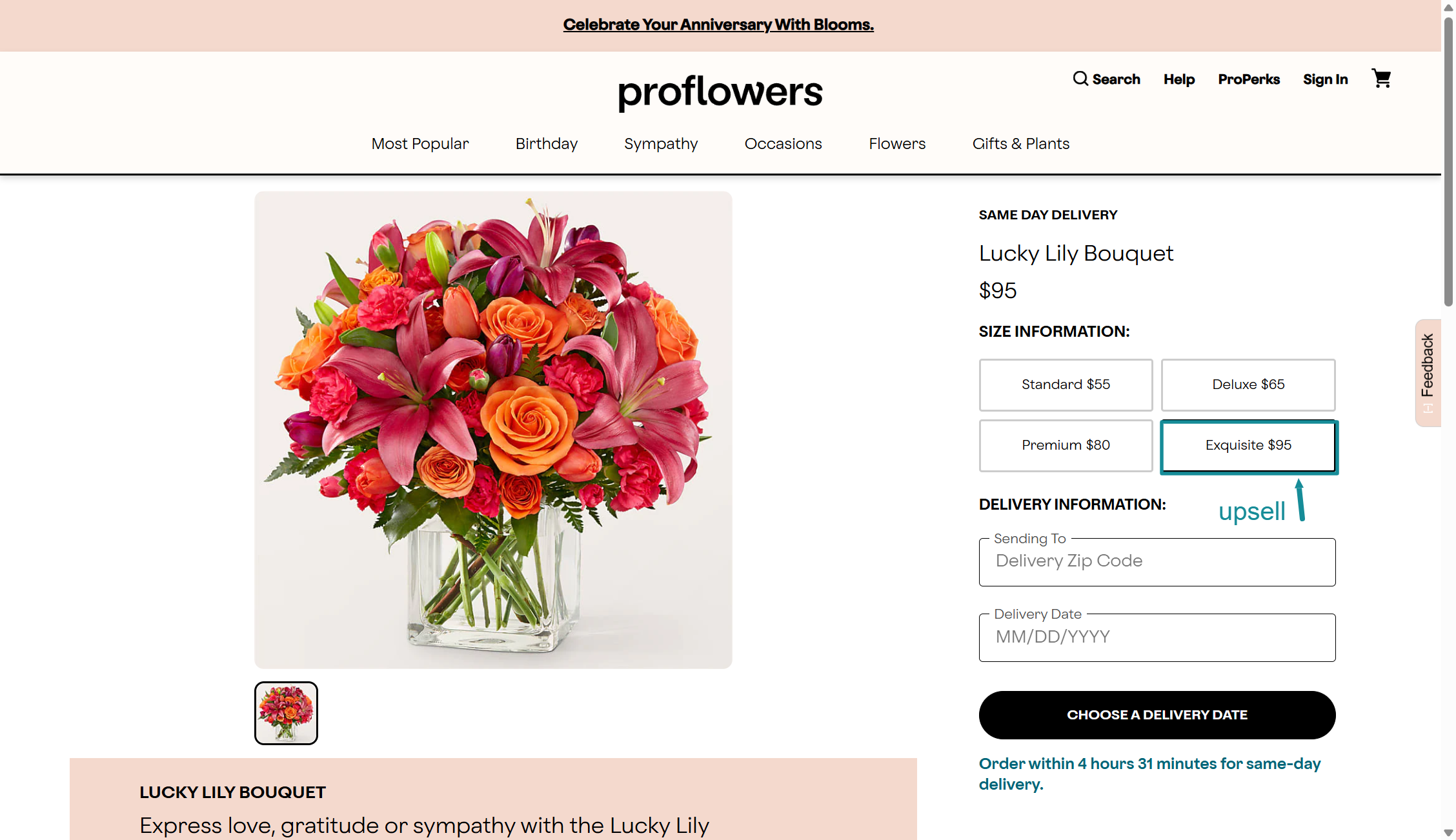
If someone is already committed to buying a laptop, offering the upgraded model feels logical and often delivers a larger revenue lift.
Cross-selling, on the other hand, is perfect for discovery.
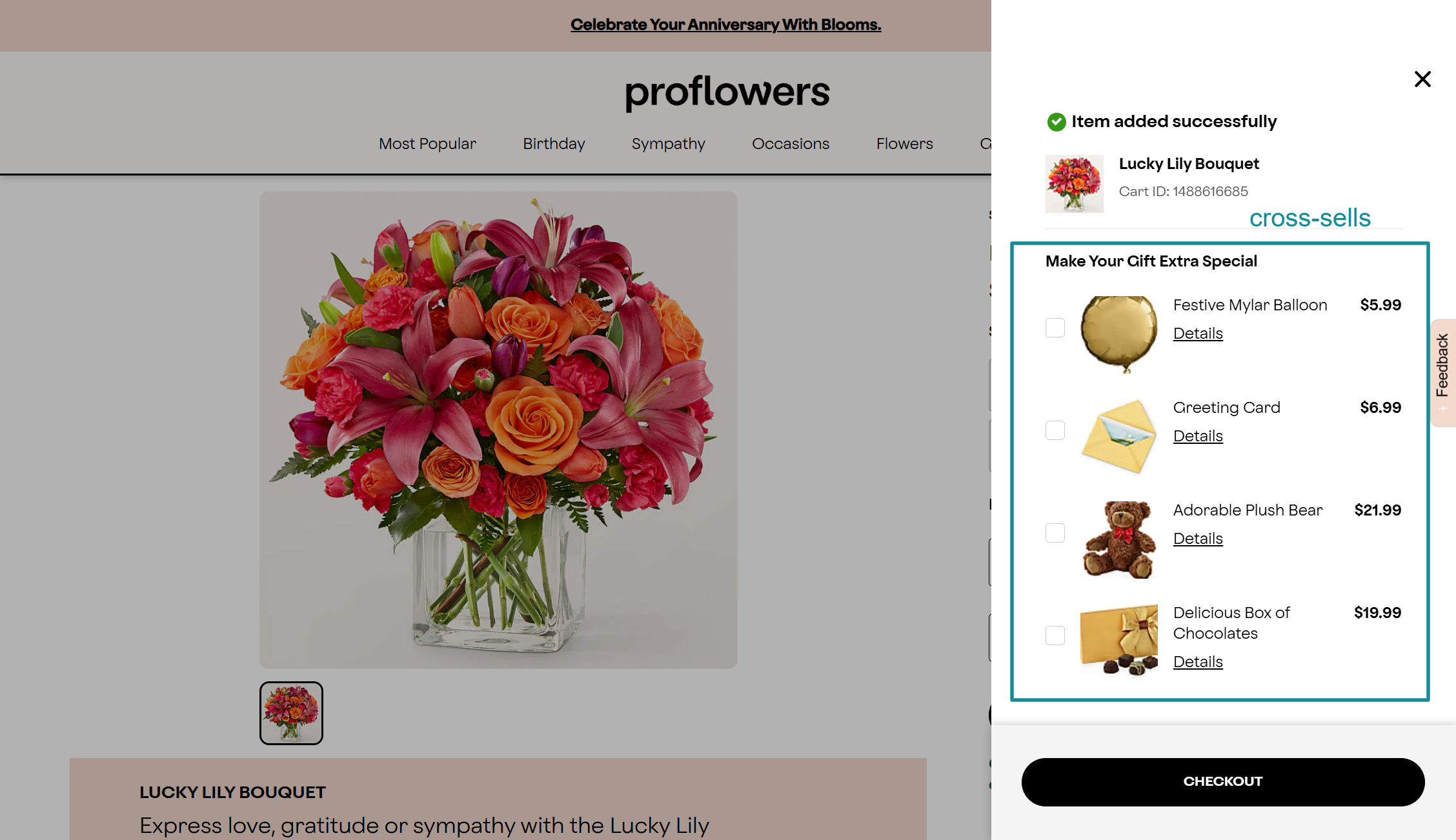
It introduces customers to items they didn’t know they needed, like cases, accessories, or add-ons.
While the lift per order may be smaller, it improves product adoption and overall customer experience.
The most effective stores use both. Upsells maximize the value of the main purchase, while cross-sells stack on complementary items.
Together, a combined upselling and cross selling strategy create a seamless shopping flow where customers feel guided, not pressured.
Why Upselling Matters More Than You Think
Customer acquisition costs are rising, which makes it harder to grow profitably by just bringing in new buyers.
That’s where upselling and cross-selling shine. They let you squeeze more value out of the traffic you’re already paying for.
Here’s a real-world example.
.png)
Let’s say you add simple upsell and cross-sell offers that bump your average order value (AOV) by just $5.
Doesn’t sound like much, right?
But run the numbers over a year, and it adds up fast:
- Orders: 5,400
- AOV without upsells: $72 -> Annual revenue: $388,800
- AOV with upsells: $78 -> Annual revenue: $421,200
- Profits without upsells: $78,800
- Profits with upsells: $105,840
That’s a 34% profit lift, just by increasing AOV slightly. The profit margin jumps from 20.3% to 25.1%, a huge win without needing to acquire a single new customer.
And it’s not just about revenue. Upselling and cross-selling make the buying journey smoother.
They help customers find the right products, discover items they didn’t know they needed, and often get better value for their money.
The bottom line: upsells and cross-sells are the fastest way to grow profits and improve customer experience at the same time.
8 Proven Upselling & Cross-selling Tactics to Try
Not every upsell looks the same. The way you present an offer shapes whether customers accept or ignore it. Here are the most common types:
1. Product page placements
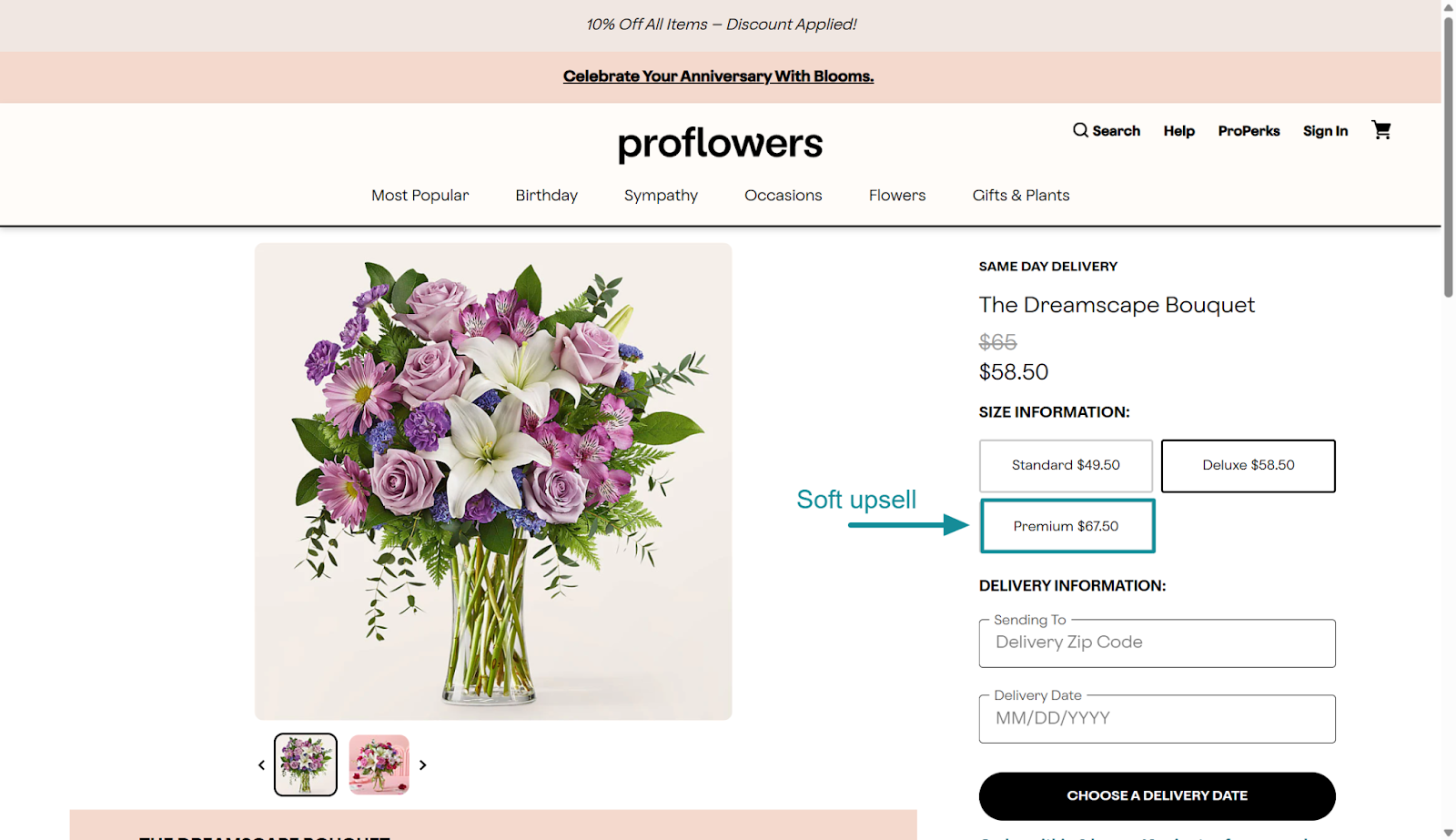
Product page upsells are the least intrusive. Think Amazon’s “Frequently Bought Together” or fashion brands’ “Complete the Look.” ProFlowers example above simply presents the customer with the option to upgrade to a premium bundle (notice the nice downsell ‘standard’ option too!)
Here’s another example I whipped together using a fake snowboard brand offering customers a better board than the one they’re looking at:
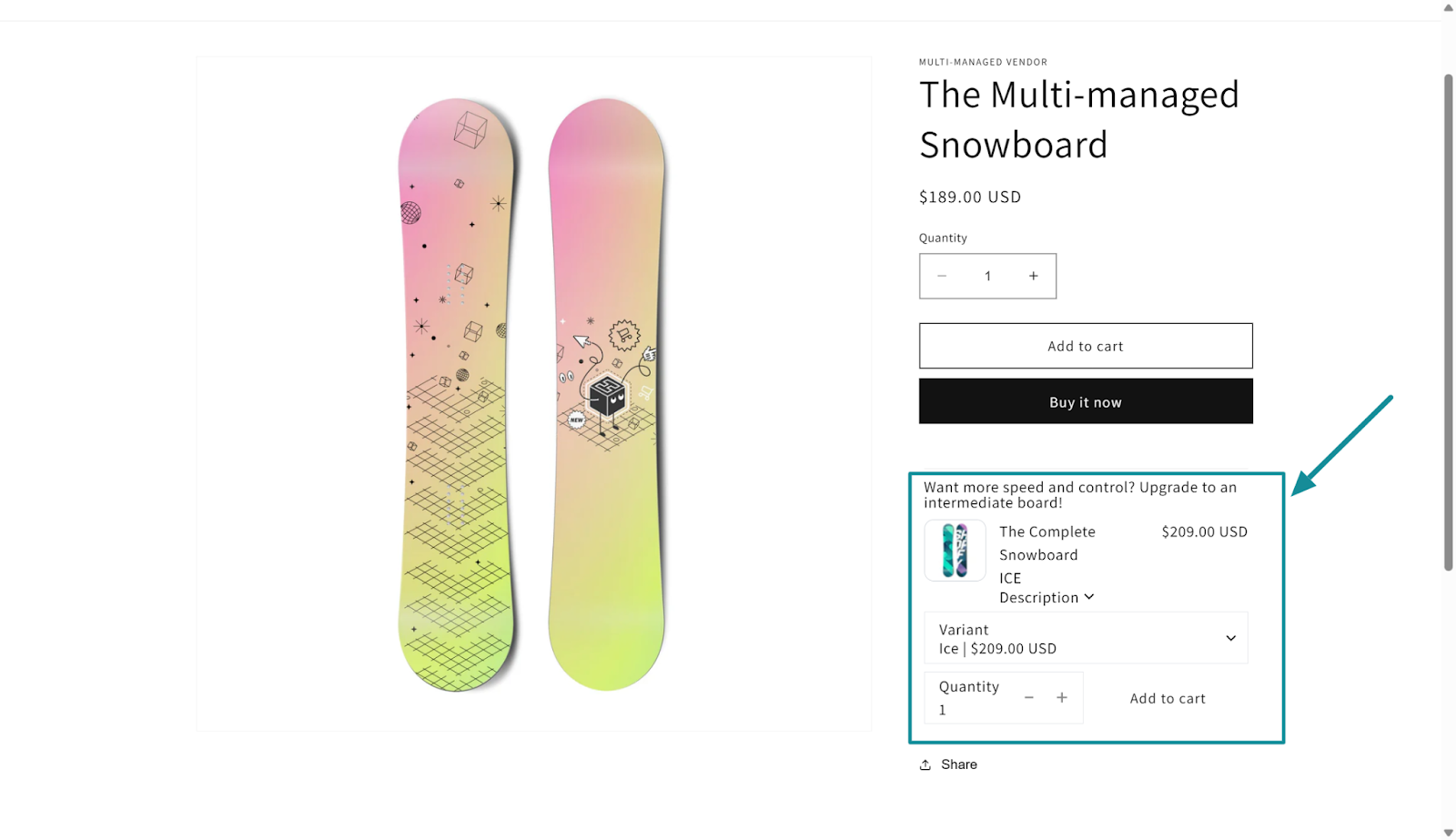
These work because they’re unpushy. Customers can add low-ticket extras with one click, without disrupting the purchase flow.
2. Product page pop-ups
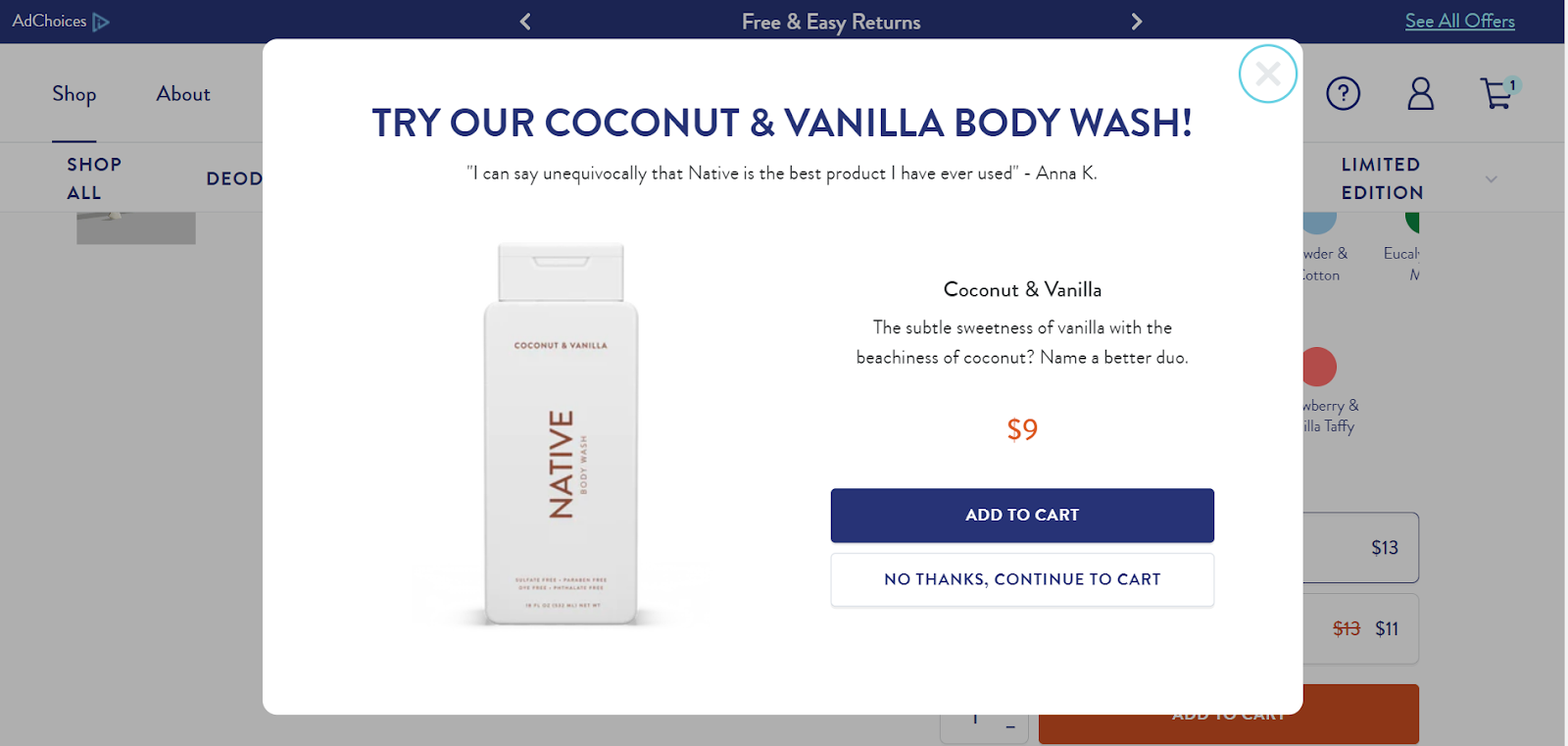
Pop-ups are more direct and attention-grabbing. Some are passive (easy to close), while others are active, requiring a yes/no response. Above is an example from cosmetics brand Native. Native includes a nice touch of social proof to boost conversions. Pop-ups are highly effective for spotlighting complementary products right before checkout.
3. Product bundling
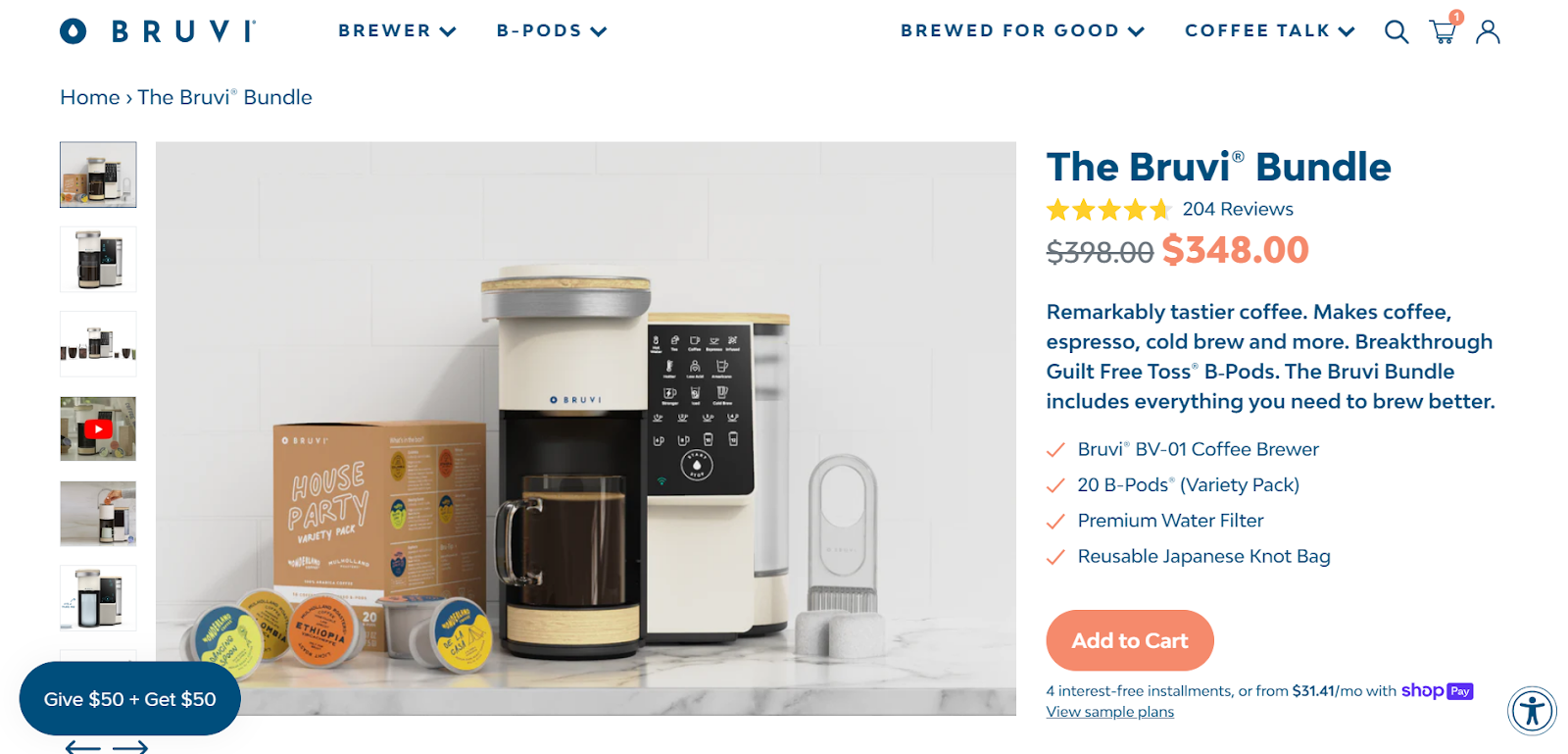
Bundling lets you package related products together at a discounted price, boosting AOV while simplifying the buying decision. Bruvi does this well by offering their coffee brewer with pods, a water filter, and a reusable bag as a single bundle. Customers see more value, and the brand secures a larger sale in one click.
4. Upsells in the Cart Drawer or Cart Page
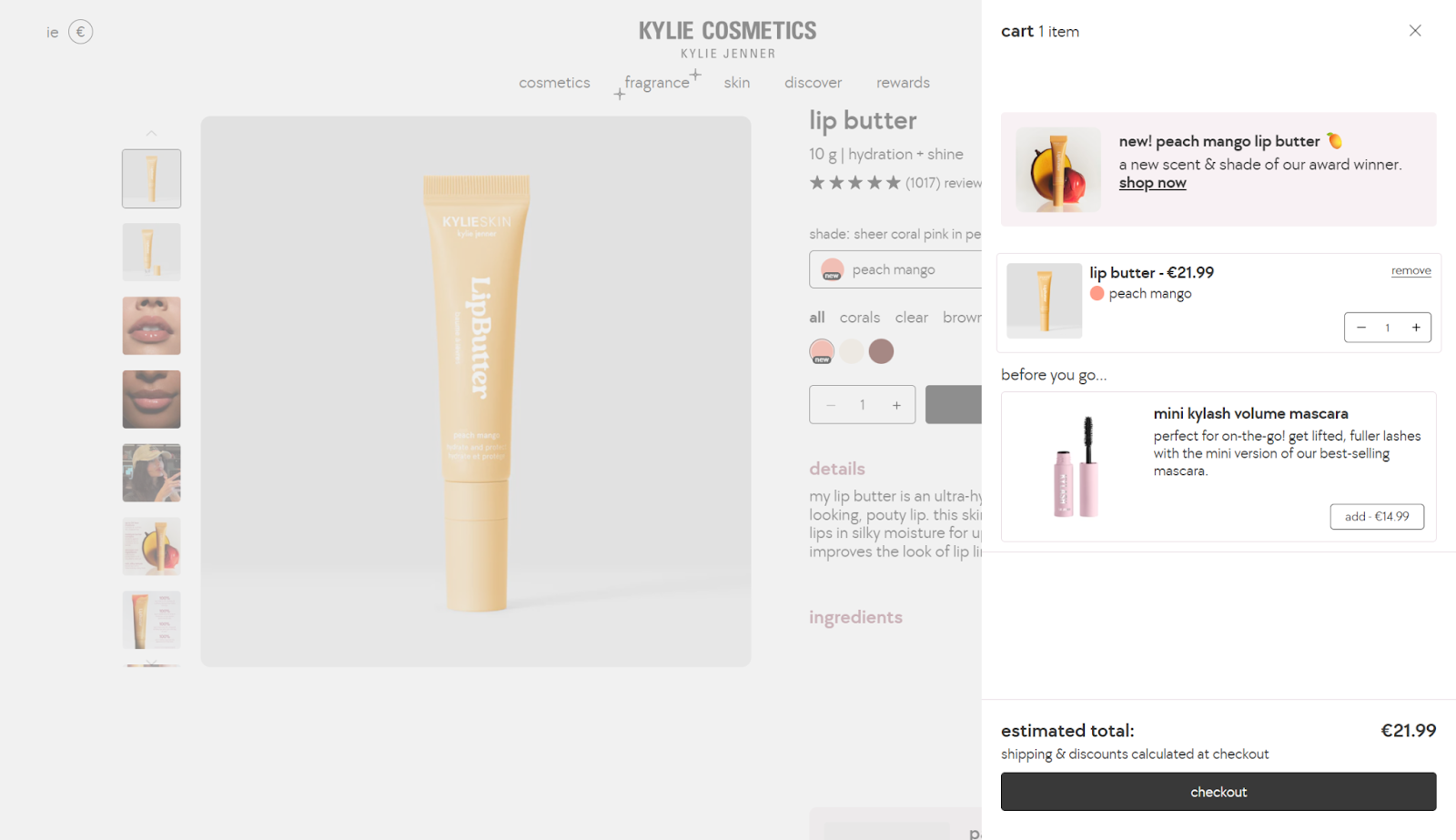
The cart drawer is prime real estate for low-ticket add-ons. Customers are already committed to buying, so a quick suggestion like socks, chargers, or travel-size items feels natural and easy to accept.
5. One-Click Upsells After Checkout
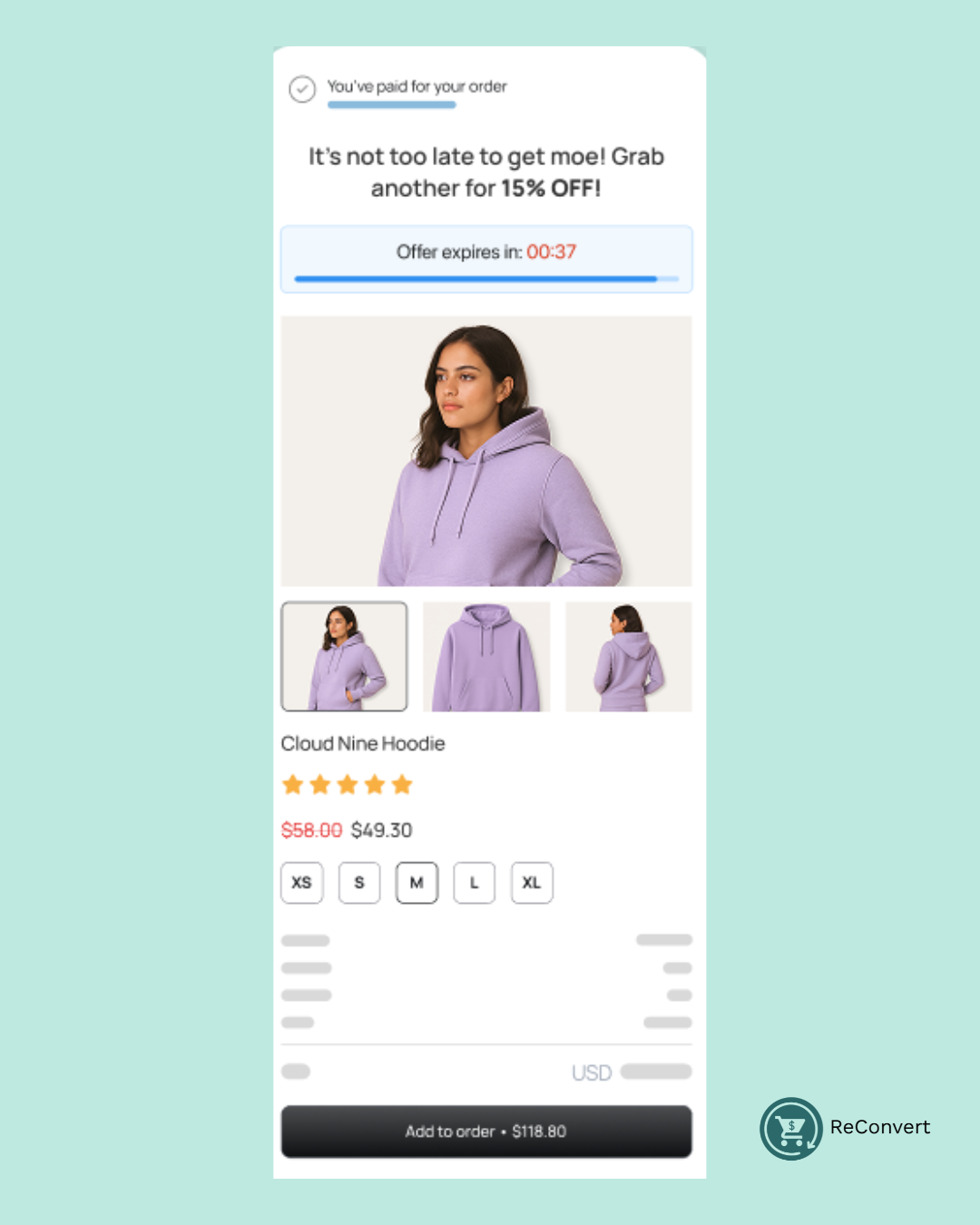
One of the most powerful formats is the one-click post-purchase upsell. Since payment details are already captured, shoppers can add upgrades or bundles instantly. There’s no extra friction, making it one of the highest-converting upsell types.
6. Thank You Page & Order Confirmation Page

The thank you page and order confirmation page often get ignored, but it’s the perfect place for another upsell. Customers are still engaged and excited about their purchase, so surfacing a relevant add-on or discount here can capture extra revenue with almost no resistance. Plus, your offers get more impressions as customers come back to check for shipping updates.
7. Live chat upsells
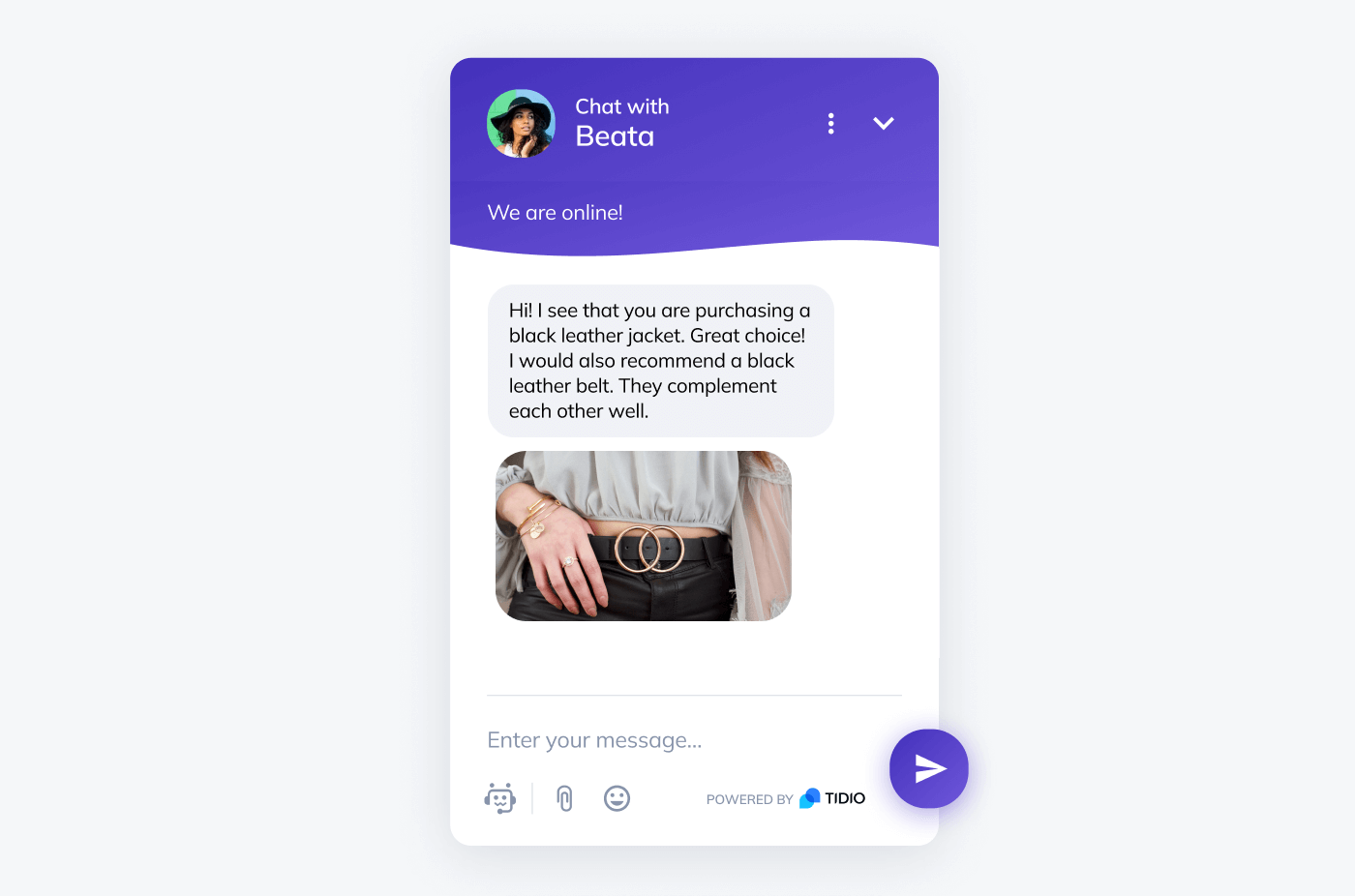
For some purchases, a live chat recommendation can make the difference. Research shows shoppers are almost three times more likely to buy after chatting with support. It’s resource-intensive, but powerful for premium items.
8. Email follow-ups
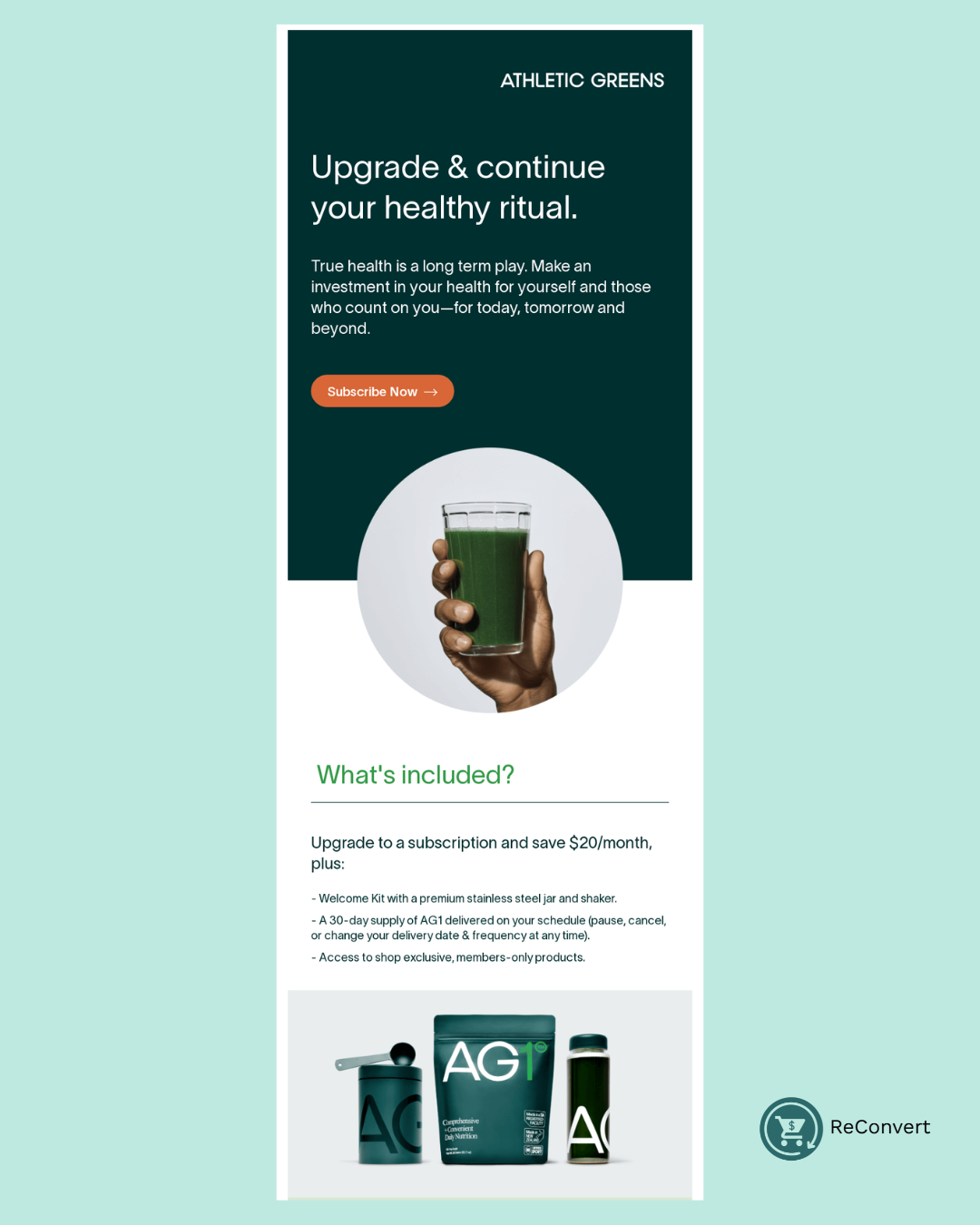
Upselling doesn’t stop at checkout. Post-purchase emails, order confirmations, and abandoned cart flows are all effective channels for nudging customers toward upgrades or add-ons.
3 Types of Upsell Offers That Work
Upselling comes in many forms. At its core, it’s about nudging customers toward more value — for them and for your business. Here are the most common upsell formats you’ll see in eCommerce and beyond:
1. Upgraded Products
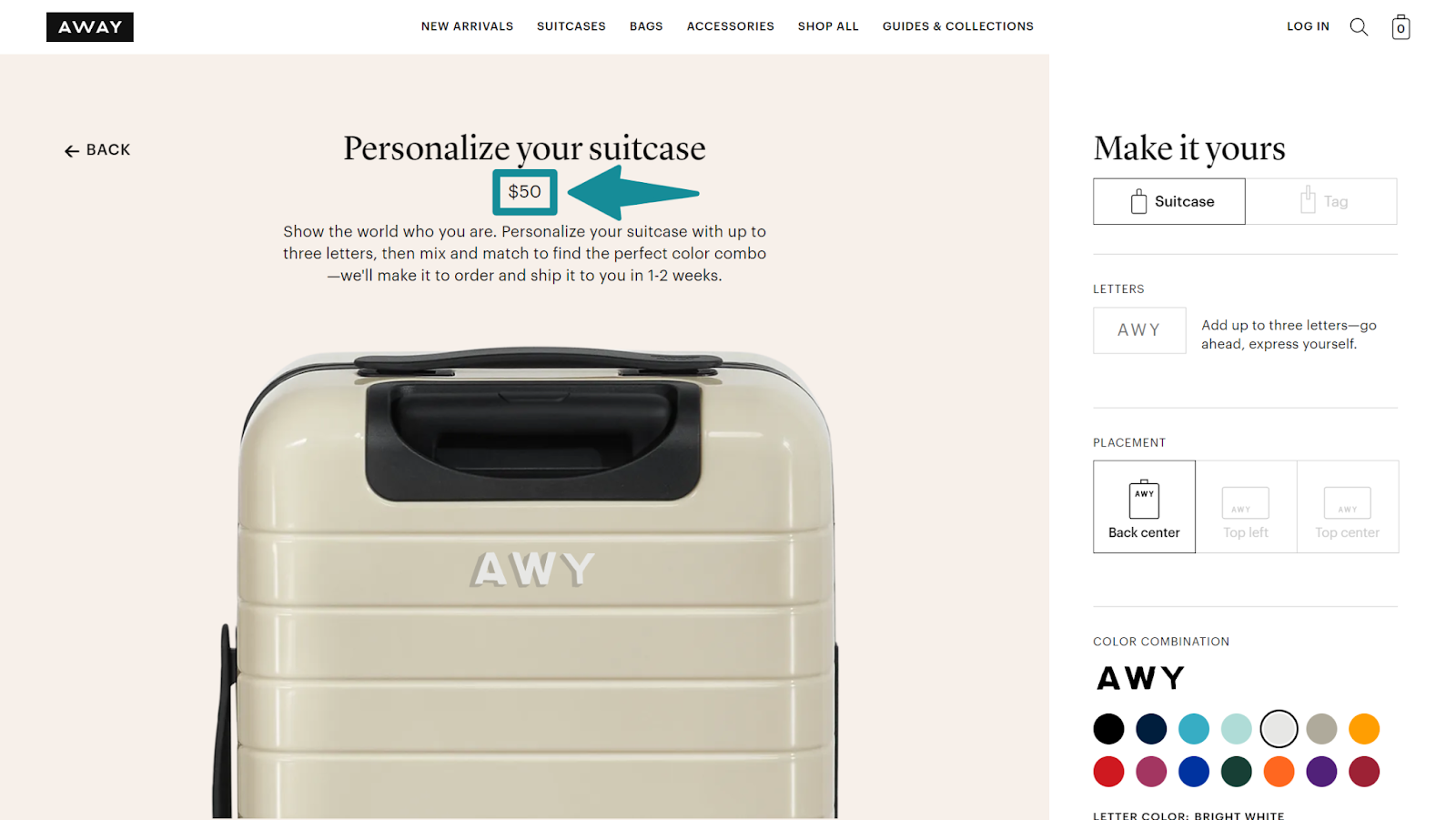
The classic upsell is moving a customer to a higher-tier version of what they’re already considering. In this example from luggage brand Away, they let customers personalize their product for $50 extra. Same category, better option.
2. Larger Quantities
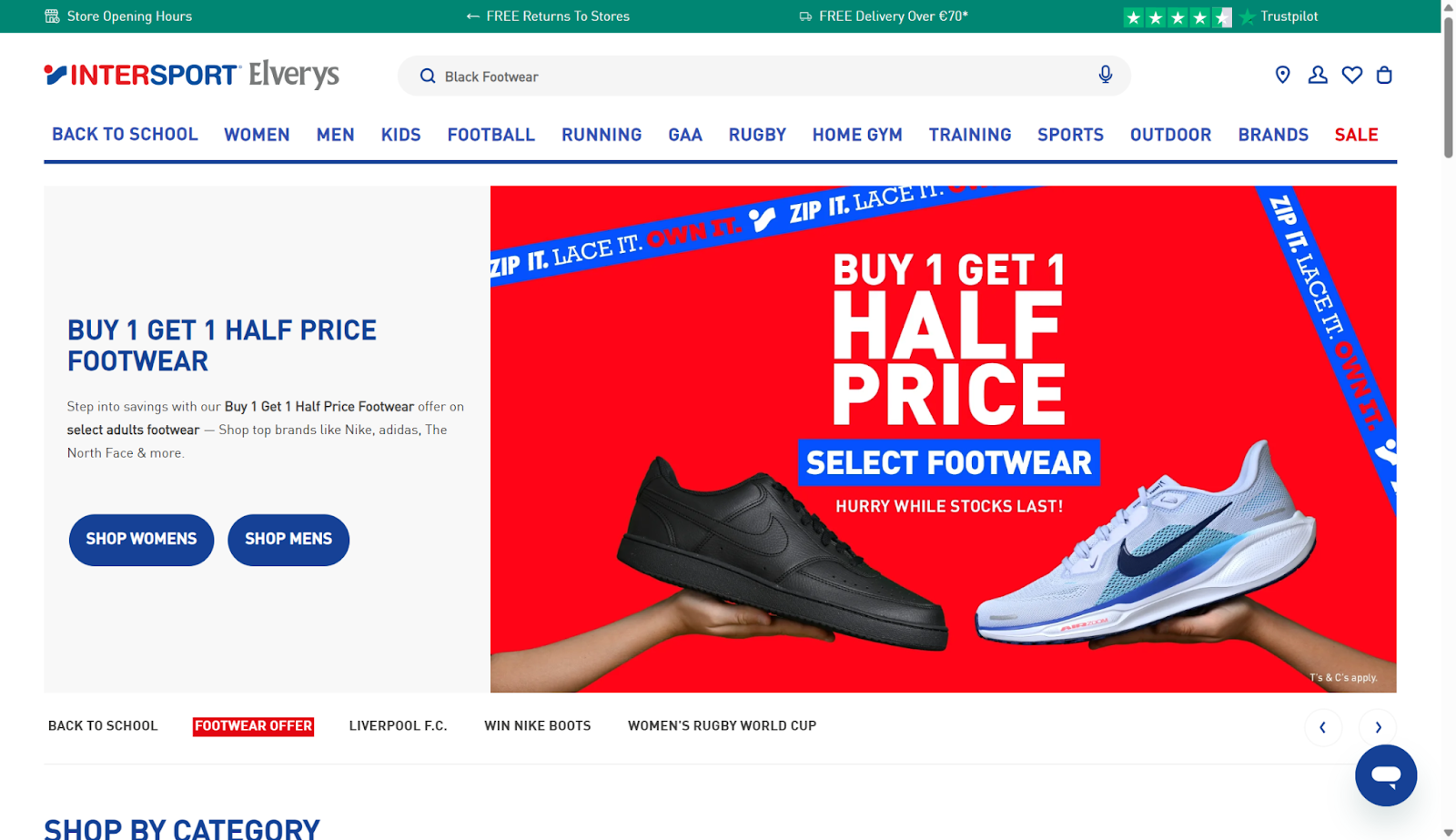
“Buy one, get one” (BOGO) and volume discounts have been proven to work. In fact, more than 90% of shoppers say they’ve taken advantage of a BOGO deal at least once. Offering a second item at a discount, or tiered deals like “Buy 2, Save 10%,” “Buy 3, Save 15%,” is a smart way to lift order value on items people purchase frequently - think snacks, cosmetics, or apparel.
3. Subscriptions
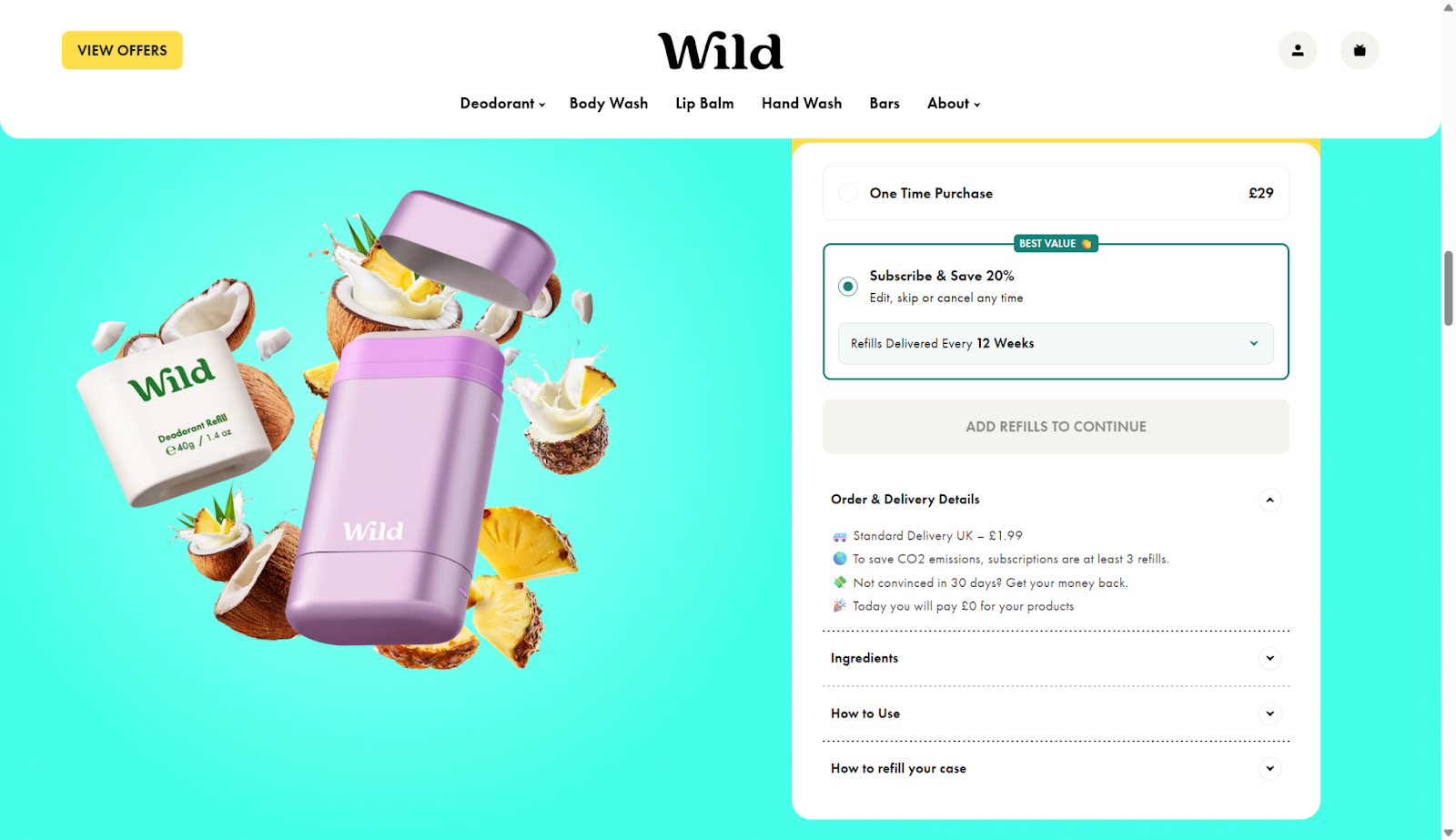
Subscriptions are no longer limited to software. They’ve gone mainstream across categories like food, hygiene, and fashion. Offering a subscription secures repeat revenue for your business and convenience for your customers. For consumables like coffee or cosmetics, subscriptions remove the hassle of reordering and ensure customers never run out.
The best part? These upsell formats are flexible. You can mix and match them depending on your products and audience, layering upgrades, volume deals, and subscriptions to maximize revenue without breaking the customer experience.
6 Principles of Effective Upselling
Upselling works best when it feels natural and valuable for the customer. The goal isn’t to squeeze more dollars out of every transaction, it’s to guide shoppers toward the product that truly fits their needs. Here are the core principles that make upselling work.
1. Keep It Customer-First
The fastest way to kill a sale is to push too hard. Upsells should feel like a helpful suggestion, not a sales trap. Always give shoppers the option to decline with a single click. When customers walk away feeling like they scored a great deal, they’re far more likely to come back.
2. Make It Relevant
An effective upsell is always closely tied to the product the shopper is already considering. Think “better version of the same thing,” not a completely different category. If someone’s buying a snowboard, a premium snowboard is relevant; skis are not. The closer the connection, the higher the conversion rate.
3. Stick to the 25% Rule
Price jumps that feel too steep almost always kill momentum. A safe rule is to keep upsells within 10–25% of the original purchase price. That way, the upgrade feels like a smart step up, not an overspend.
4. Add Exclusivity
Upsells perform best when they’re framed as special, limited-time opportunities. If the customer believes they can come back and get the same deal tomorrow, the urgency is gone. Position upgrades as “only available now” and watch conversions climb.
5. Personalize the Offer
Data should drive your upselling strategy. Use browsing behavior, purchase history, or even cart contents to recommend the most relevant upgrades. Shoppers are 75% more likely to buy when offers are personalized, which makes this one of the most powerful levers you can pull.
6. Test Relentlessly
There’s no such thing as a perfect upsell on the first try. Success comes from testing and iteration. Experiment with placement (product page, cart drawer, thank-you page), incentive size, copy, and creative. Just remember: change one variable at a time so you know what actually moves the needle.
No matter what industry you’re in, these principles hold true.
What is Upselling in Different Industries?
Upselling isn’t just for eCommerce. It’s a universal sales tactic that works across industries, both online and offline. Here’s how it plays out in different contexts:
Upselling in Retail
Brick-and-mortar stores lean heavily on upselling too. When a clothing store associate suggests a premium fabric upgrade, or when Best Buy promotes an extended warranty with your new TV, that’s retail upselling in action. The key here is placement - positioning premium products beside standard ones so customers can compare value.
Upselling in Hotels & Travel
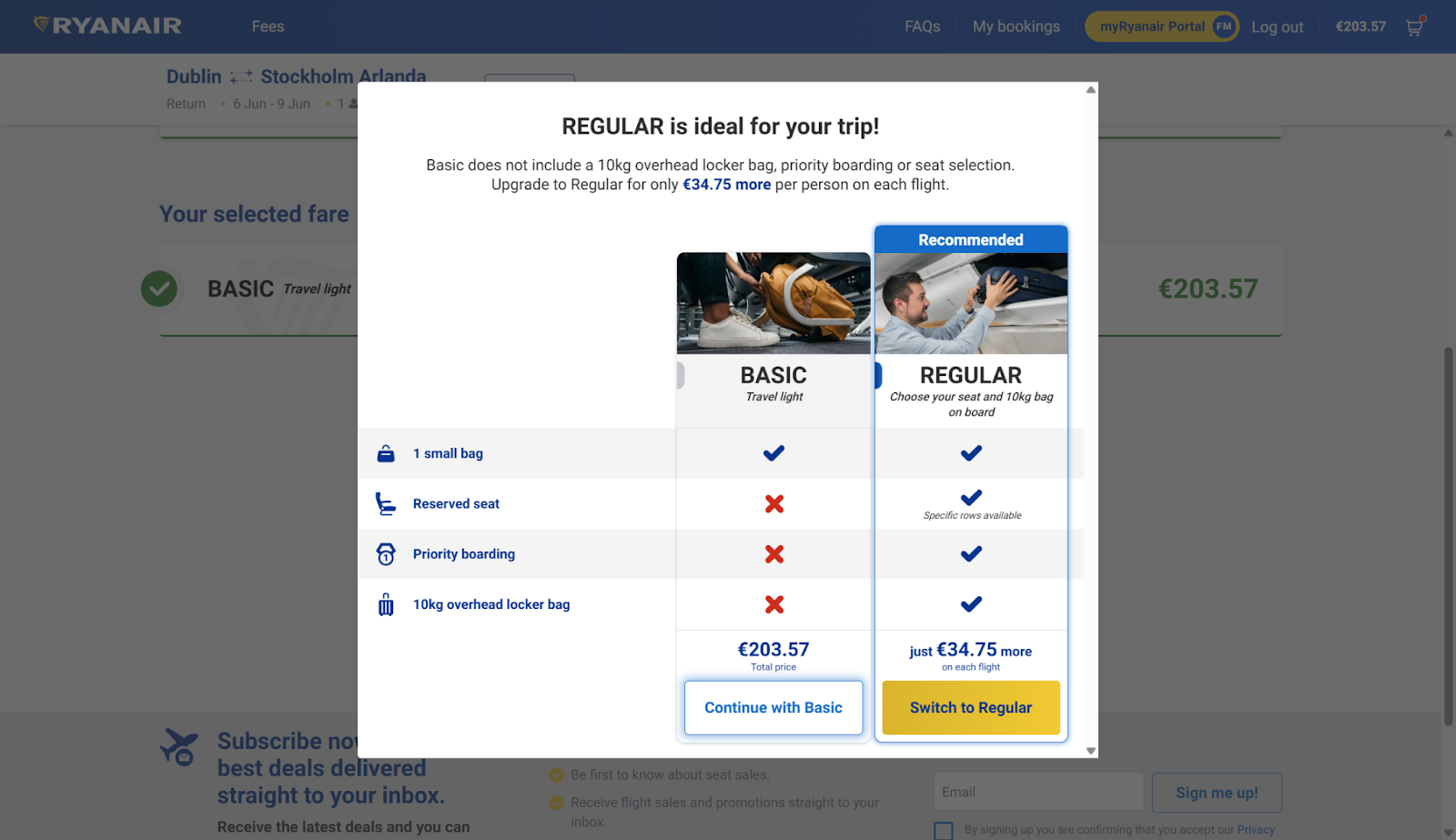
Hotels upsell by offering room upgrades (bigger suite, ocean view), early check-in, or add-ons like spa packages and breakfast. Airlines are masters of this too: extra legroom, priority boarding, or premium seats. In fact, upsells account for a massive chunk of airline profits because the infrastructure cost is already sunk, but upsells add pure margin.
📖Suggested Reading: The Secrets Behind Ryanair’s Billion-Dollar Upsell Funnel (And How to Copy Them)
Upselling in Restaurants & Cafés
Fast food made upselling famous - “Would you like fries with that?” or “Go large for $0.75.” Sit-down restaurants do it subtly with premium wine pairings, dessert recommendations, or higher-quality cuts of meat. Starbucks does it by pushing larger sizes or seasonal add-ons (like oat milk or syrup shots).
Upselling in SaaS & Digital Products
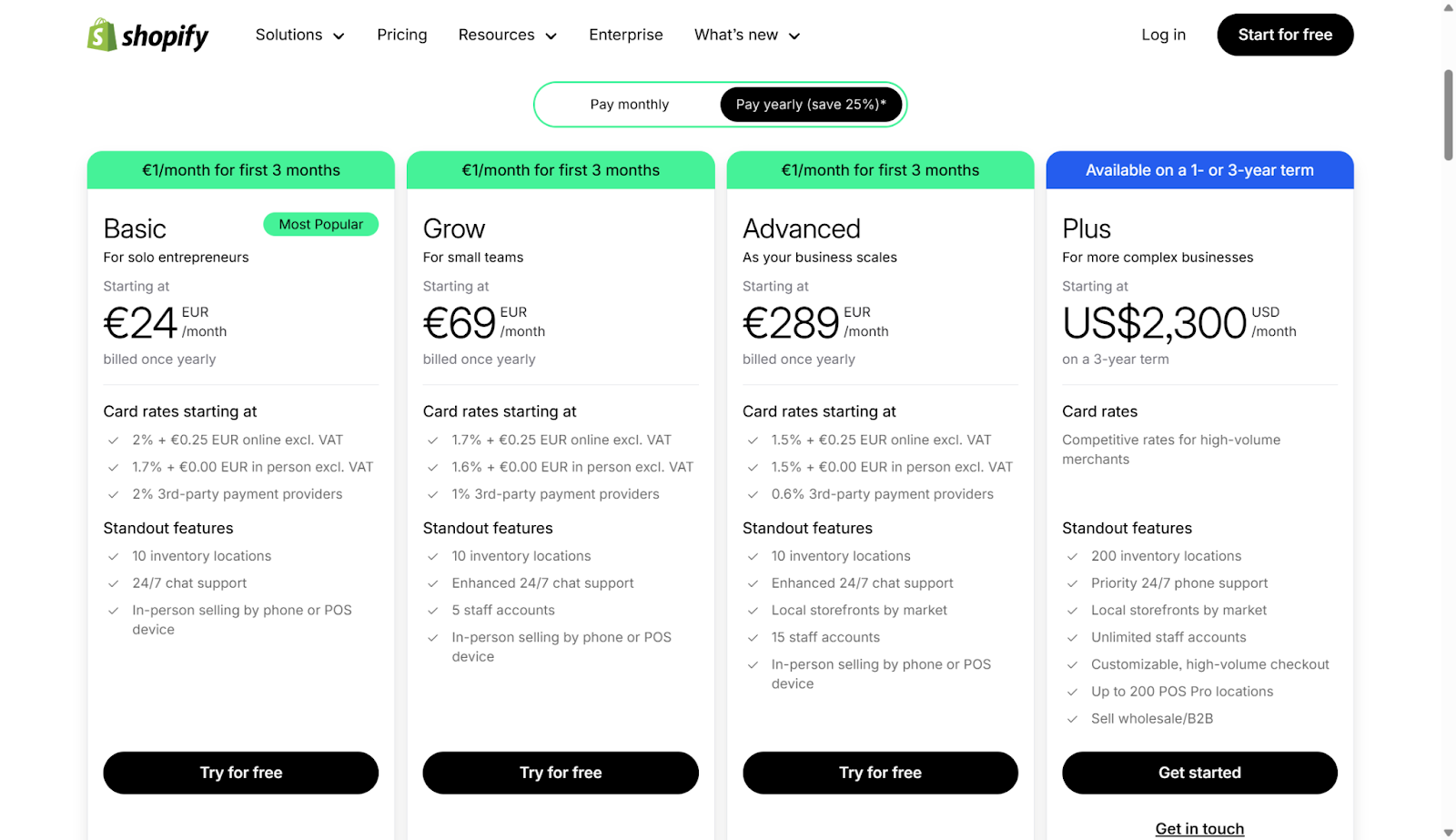
In software, upselling often means moving users to a higher-tier plan with more features, storage, or support. Think: Zoom pushing you from free to Pro, or Shopify nudging merchants into Plus. Because digital products have low marginal costs, every upsell has huge profit potential.
Upselling in Health & Fitness
Gyms and studios upsell with personal training packages, premium classes, or nutrition coaching. Even supplement brands do it - adding a “value bundle” or subscription option to increase lifetime value.
The thread across all industries? Upselling isn’t random. It’s about matching higher-value offers to what the customer is already buying, at just the right moment.
So, What is Upselling?
Upselling is a sales tactic where you guide customers toward a higher-value version of what they already want, or add complementary offers that enhance the purchase.
It’s not about pushing random products, but about making smarter recommendations at the right time - whether that’s on the product page, in the cart drawer, post-purchase, or even on the thank-you page.
Done right, upselling increases average order value by 10–30%, improves profit margins, and actually boosts customer satisfaction because shoppers walk away with products better suited to their needs.
From retail to restaurants to SaaS, upselling is a universal strategy that turns existing demand into bigger wins. For Shopify stores, tools like ReConvert make it easy to put these principles into action with bundles, one-click post-purchase offers, and thank-you page upsells.
What is Upselling FAQ
Let’s quickly cover some of the most common questions relating to the meaning of upselling:
What is the meaning of upselling?
Upselling is a sales technique where you encourage customers to purchase a higher-end product, an upgrade, or an add-on that increases the overall value of their order.
What is an example of upselling?
A fast-food cashier asking if you’d like to “supersize” your meal is upselling. In eCommerce, showing a shopper a premium version of a product - like noise-cancelling headphones instead of standard ones - is another example.
What are the 4 stages of upselling?
The four stages are: identify the opportunity, present a relevant offer, highlight the added value, and make it easy for the customer to accept or decline.
Is upselling good or bad?
Upselling is good when it’s relevant and customer-focused. It helps shoppers find products better suited to their needs while increasing revenue. It’s bad when it’s pushy, irrelevant, or harms the customer experience.
What is the difference between upselling and cross-selling?
Upselling means encouraging a customer to buy a higher-value version of the same product, while cross-selling means suggesting complementary items to go along with it.
Why is upselling important in eCommerce?
Upselling can lift average order value (AOV) by 10–30%, improve margins, and strengthen customer relationships - all without increasing ad spend.





